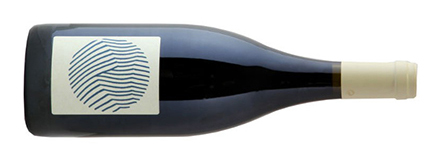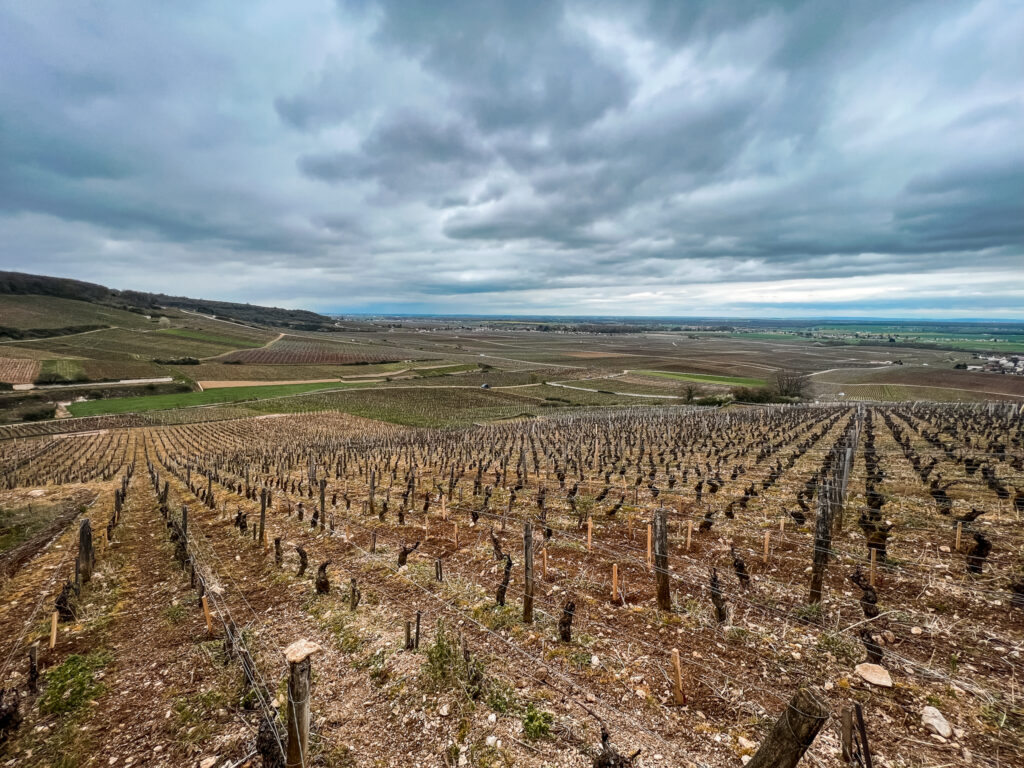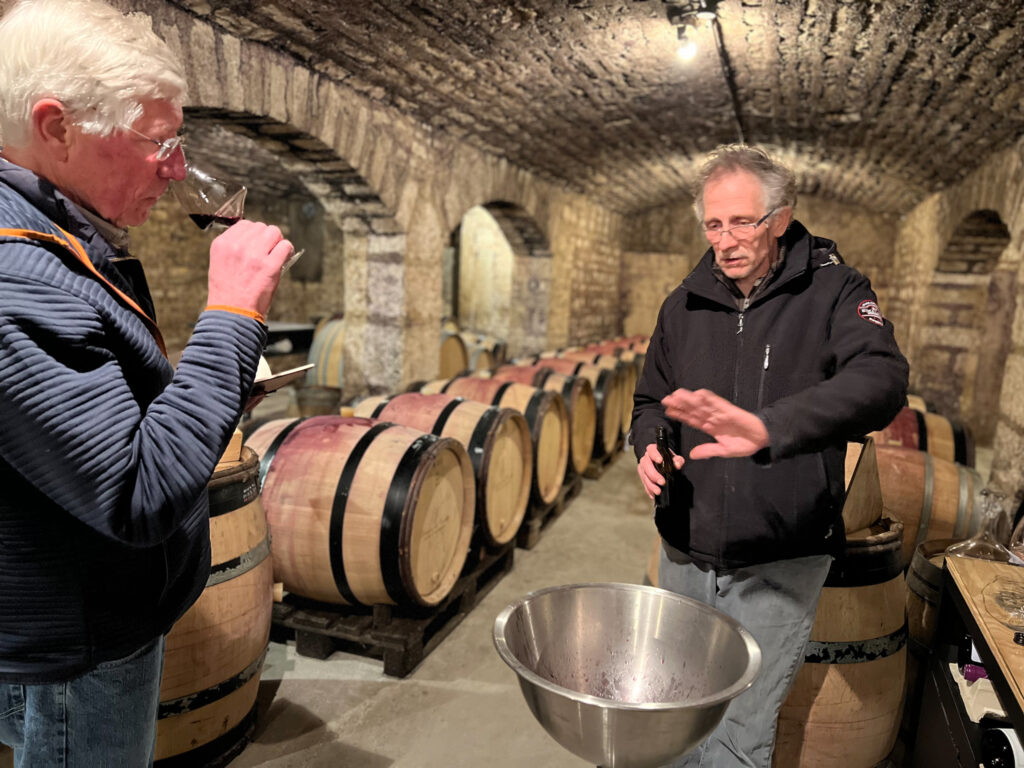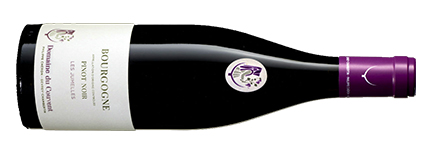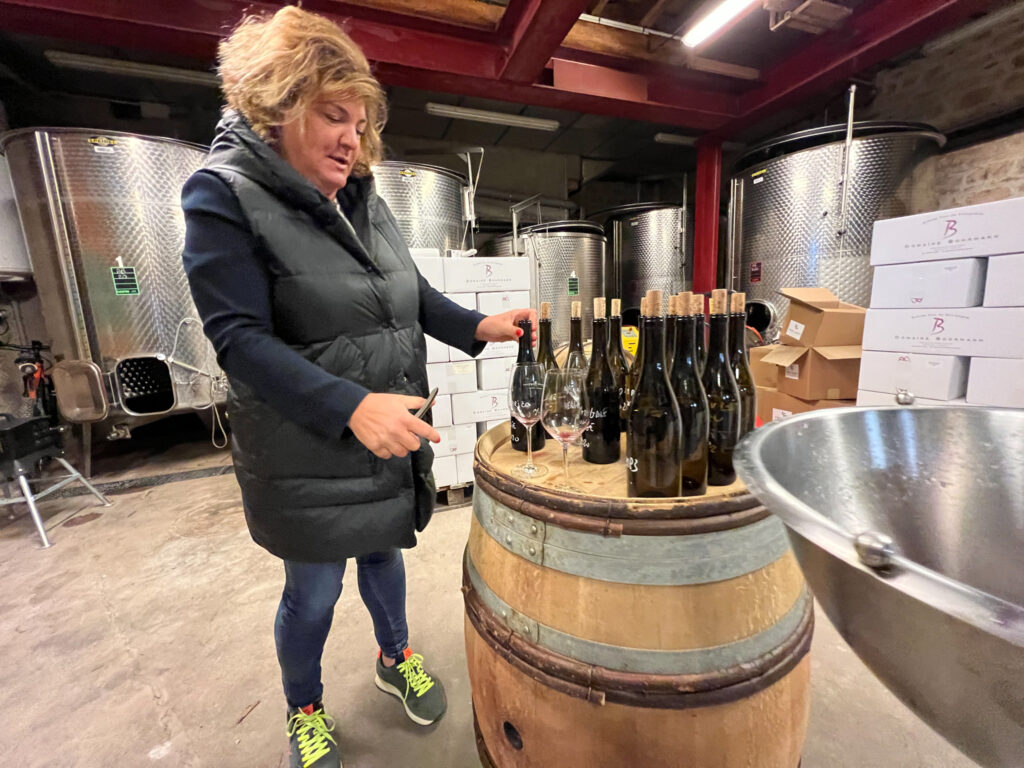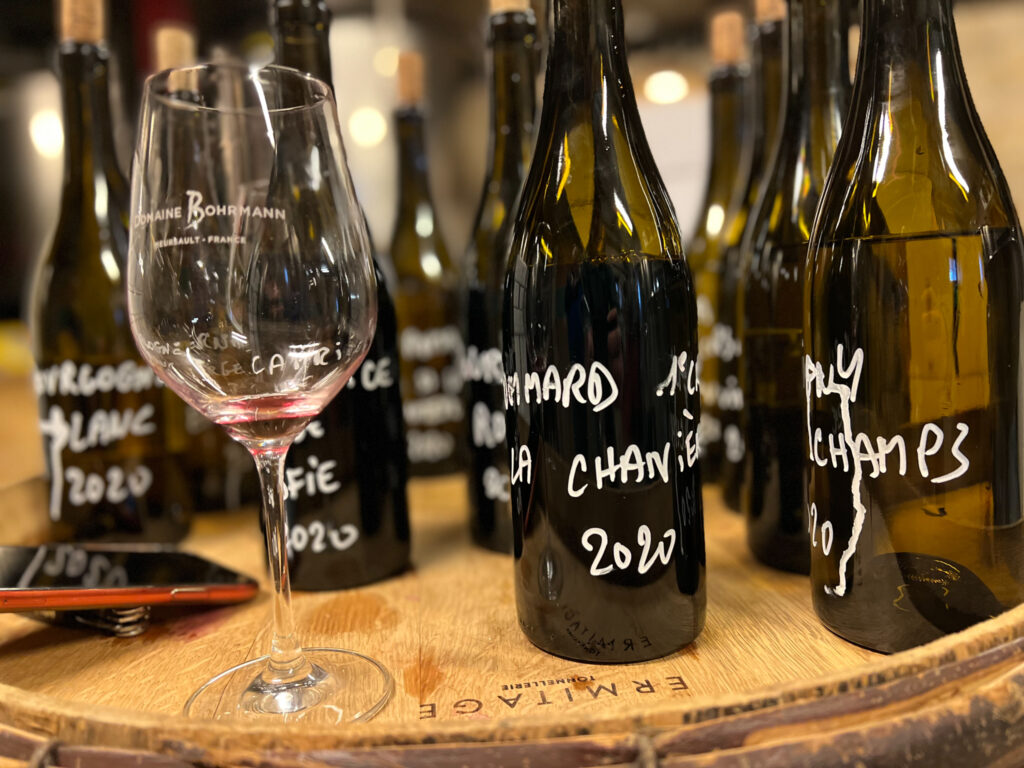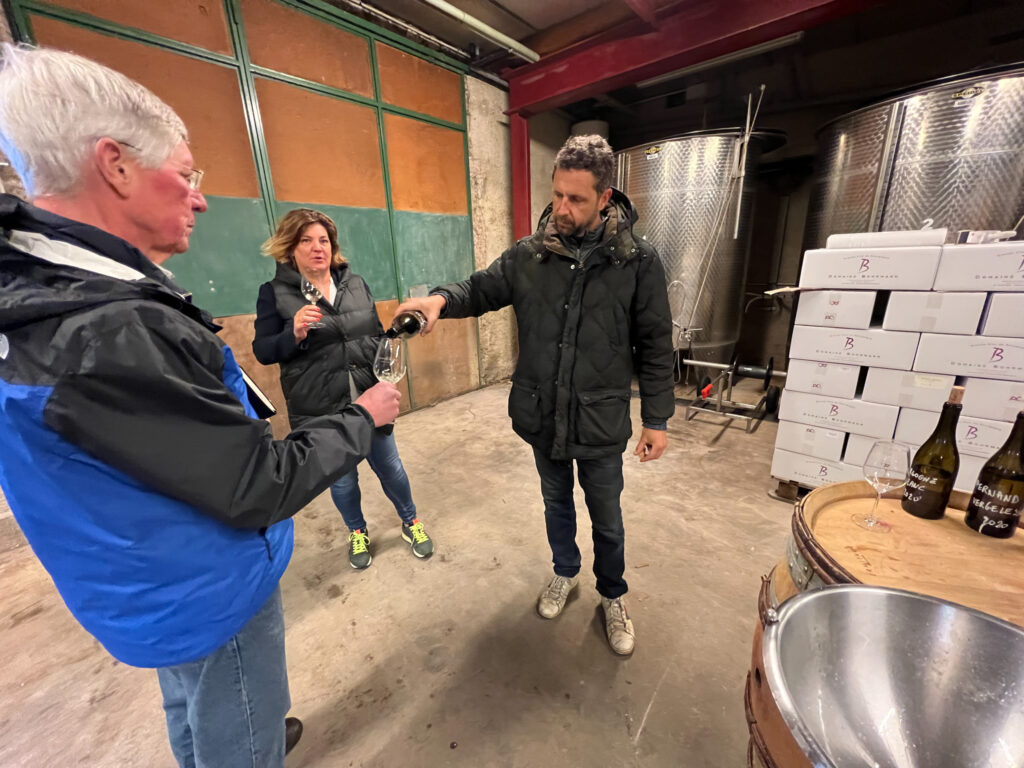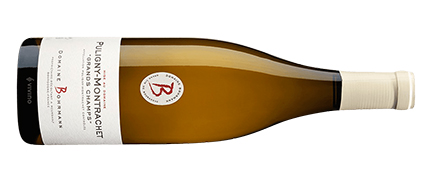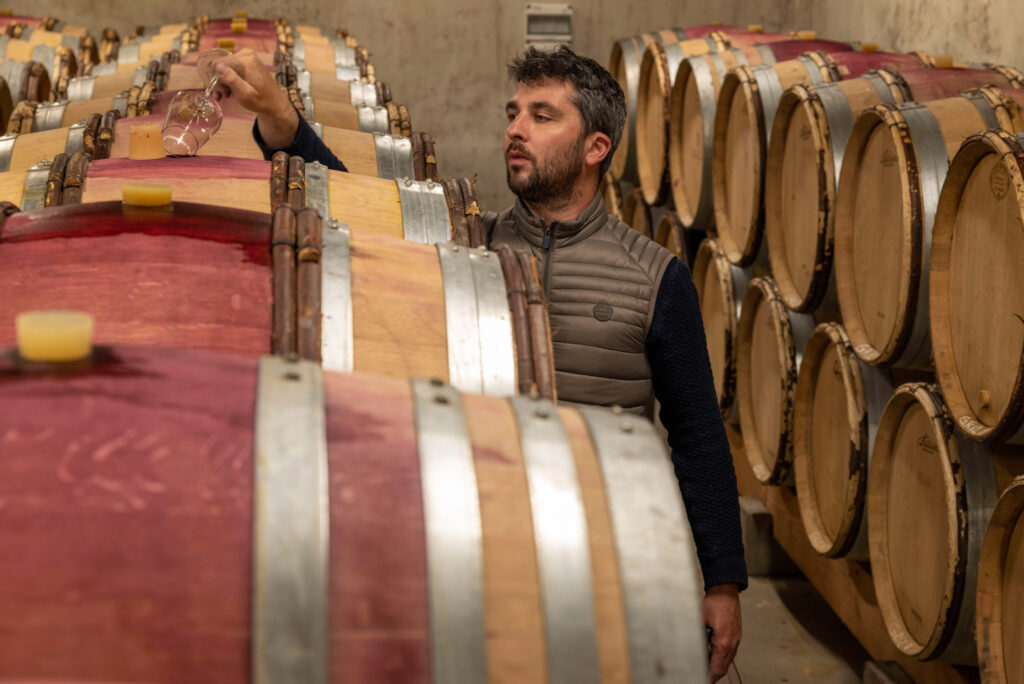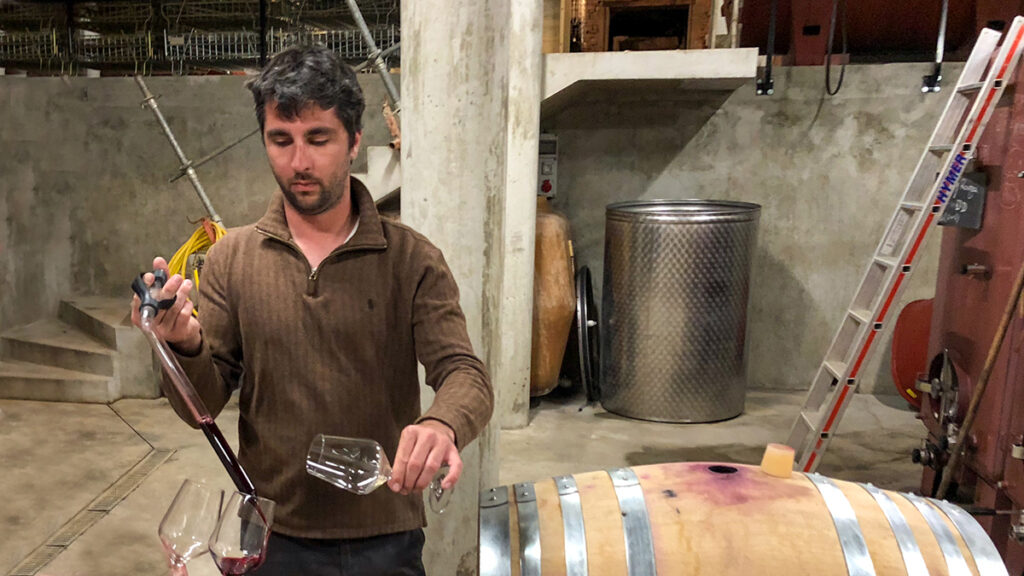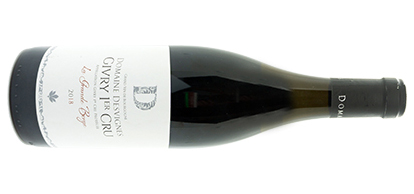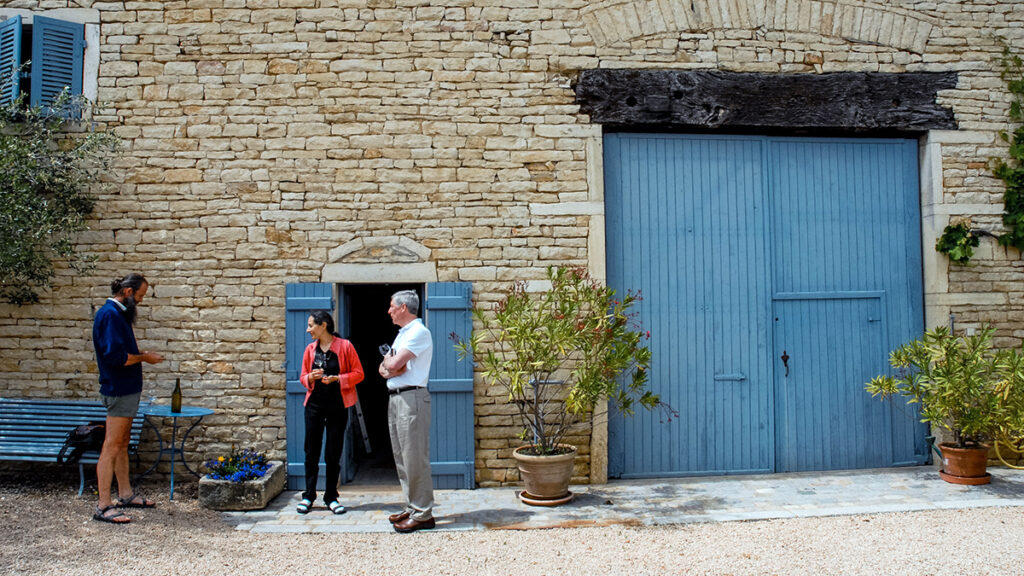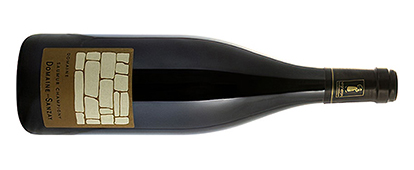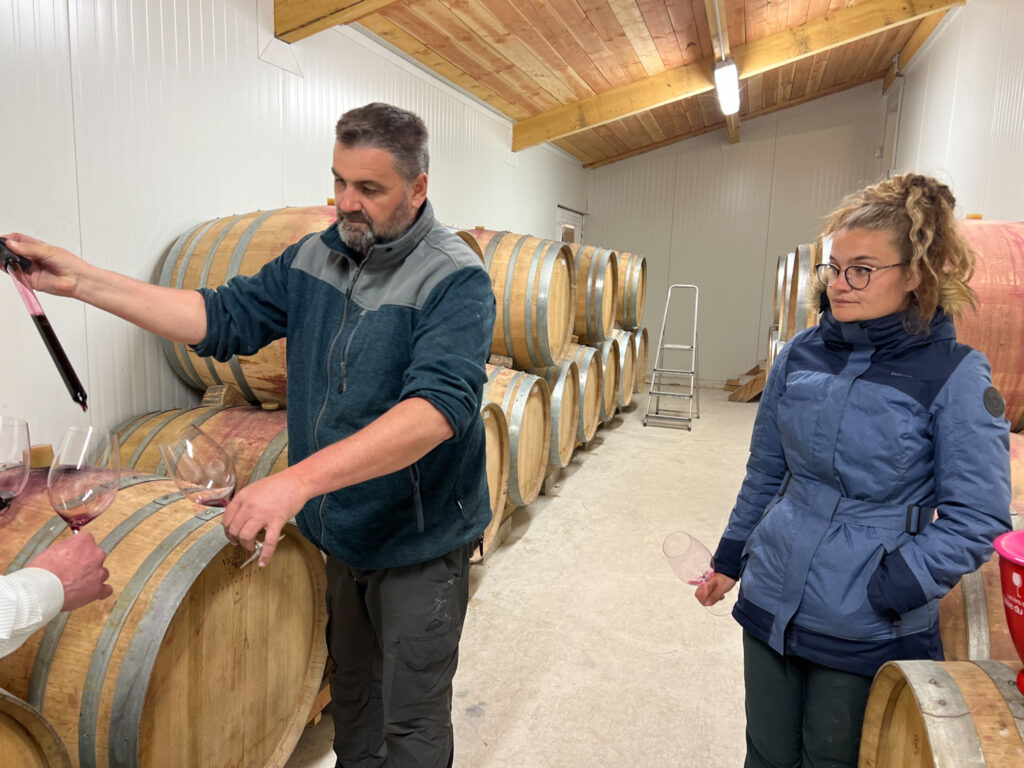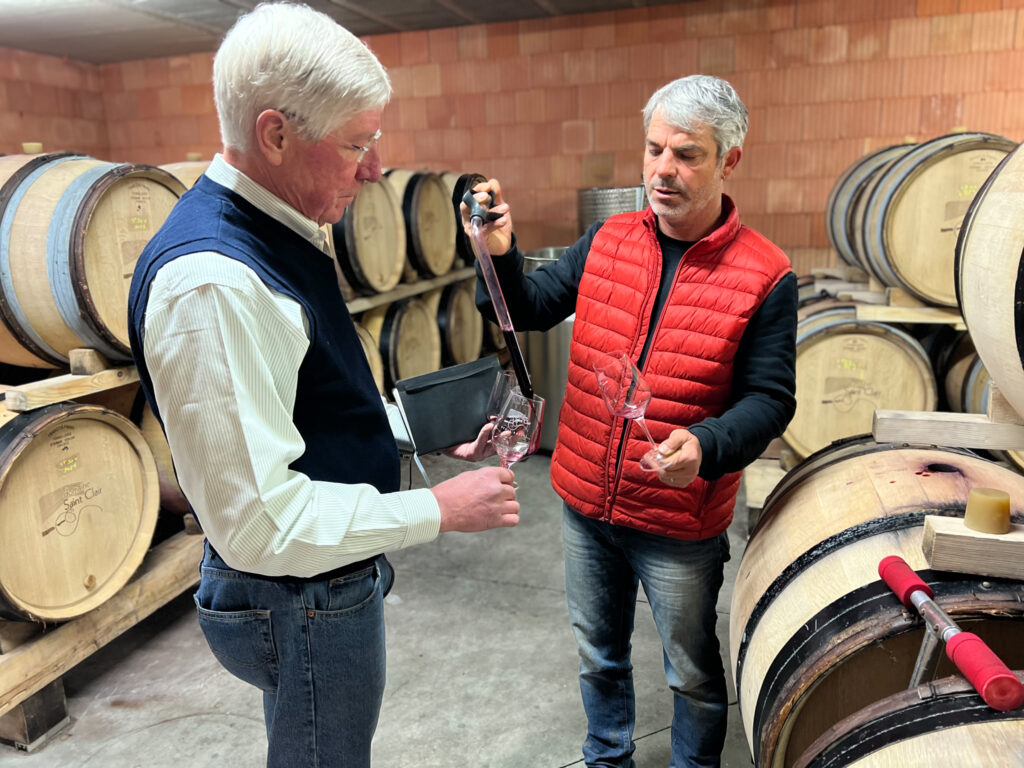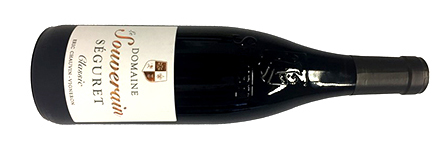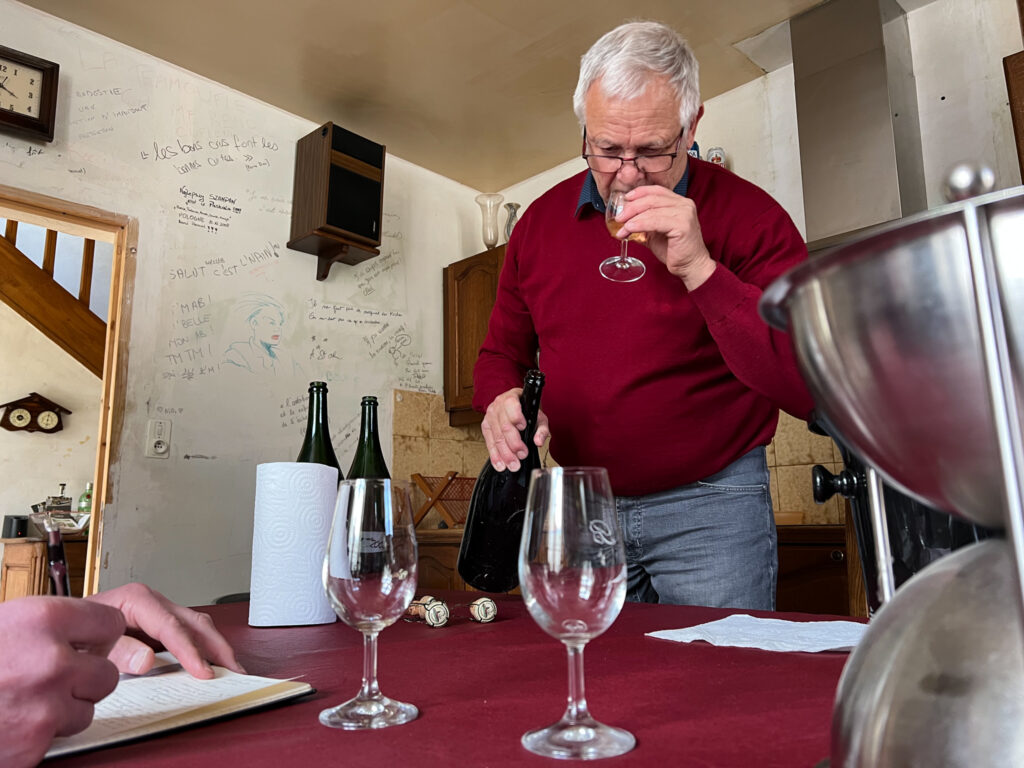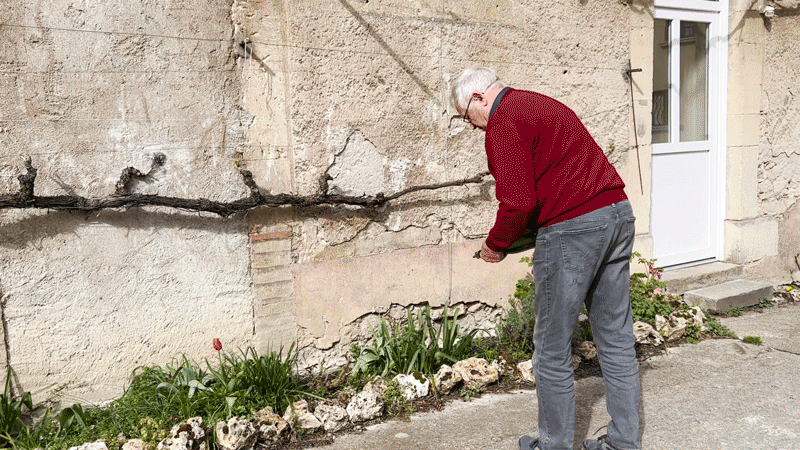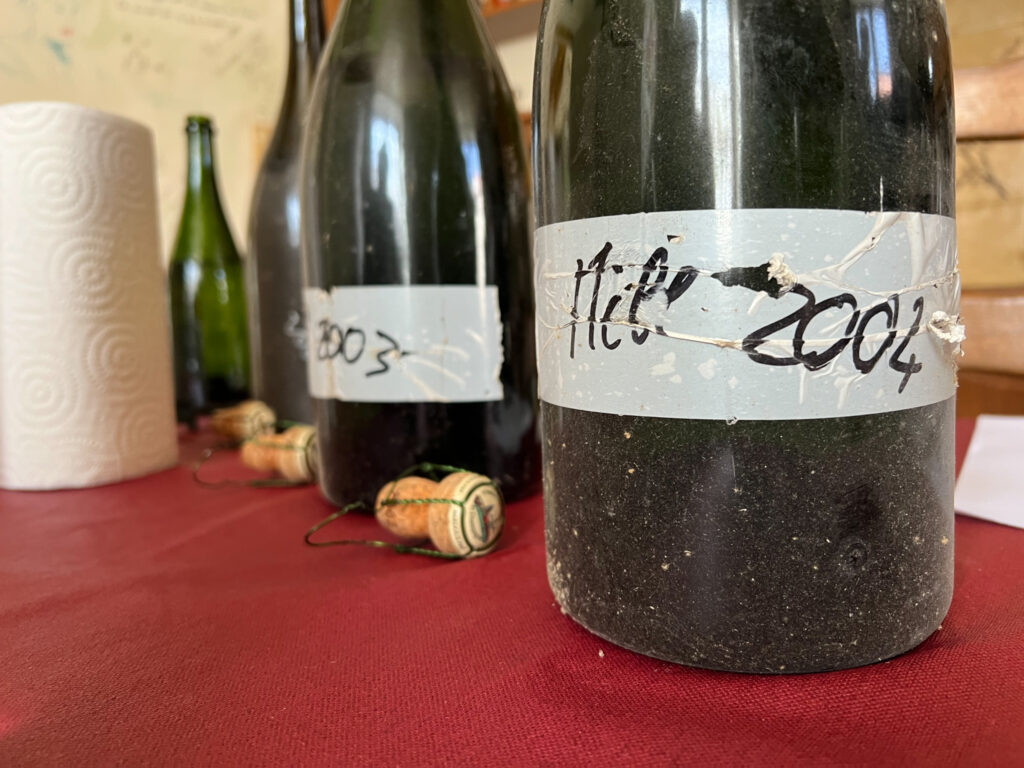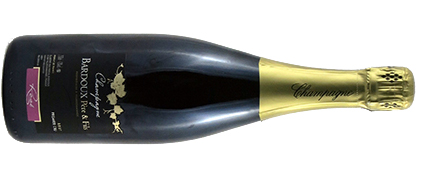9.4.22 Our September Futures Issue used to come out just as the vignerons across France were making final harvest preparations: tuning up tractors, hiring last-minute vendangeurs, checking ripeness and sugar levels in every plot. But times (and harvest dates) change, and for winemakers at least, that famous French August vacation has shrunk from four weeks to three or even two. Pictures of plump, juicy grapes in harvest bins began appearing in our Instagram feed around August 20th this year, with some domaines already finished by this weekend. The good news (provided you can ignore skyrocketing prices, supply chain woes, inflation, climate change, etc) is that the wine coming out of France, and in particular Burgundy, has never been better. The Euro’s recent plunge against the USD has softened the blow of most price increases, and we’re pleased to maintain only modest price increases over last year – some have even remained flat. The 2020 vintage in Burgundy is tiny but almost universally excellent, and we’re thrilled to offer four groups of 2020 Burgundies in this issue: Couvent for classic, ageworthy Côte de Nuits reds; Bohrmann for vibrant, delicious Côte de Beaune whites; Desvignes (our new superstar) for overperforming reds from Givry; and Forces Telluriques, a secret source for extraordinary Maconnais white. Further afield, we offer excellent and well priced Loire Valley reds from Sanzay, and two terrific groupings of Northern Rhône Syrahs: Côte Rôties from Bonnefond, and Crozes-Hermitage from Saint-Clair. Finally after a quick stop in the Southern Rhône for some delicious, crackling everyday red from Souverain, we finish in the north with some old favorites and two brand new cuvées from the philosopher vigneron Pascal Bardoux in Champagne. As readers may have noticed, our old 6-8 week delivery estimates for Futures orders are no longer the norm. When we hear from our friends elsewhere in the industry about 6-8 month delays and 10x cost increases, we’re glad we’ve been able to keep our transit times relatively quick, but unfortunately inconsistency is the only consistent thing in the supply chain these days. We’re working on some exciting new updates to Ansonia this fall, many of which we hope will smooth out some of the disruptions. As always, we appreciate your patience – rest assured all of these wines will taste better in December than October, and several are years away from their peak. Our best guess (though of course not a guarantee) is that these September Futures will arrive before Christmas. If anything is of interest, don’t forget to place your orders in case or half-case lots by the Order Deadline of September 18, 2022. We’ll be placing the orders in France immediately thereafter. JUMP TO SECTION
Couvent
Bohrmann
Desvignes
Forces Telluriques
Sanzay
Bonnefond
Saint Clair
Souverain
Bardoux
September Futures
Order Deadline 9/18
Domaine du Couvent
Nuits-St-Georges, Burgundy
On our April tasting trip we finally met Philippe Cheron in the flesh and had the opportunity to taste all of his 2020s from barrel. Cheron acquired the Domaine des Varoilles several years ago, and added its holdings to his own vines to create the new Domaine du Couvent. The 2020 vintage was the first where Cheron stewarded all the wines from vine to bottle, and so it was our first opportunity to see Cheron’s winemaking applied to the Varoilles terroir. We are pleased to report that the wines were first rate across the board. For those who follow Burghound, his first visit in January yielded similar impressions, and he concluded “I was impressed with a number of the wines and this is a domaine to watch going forward.” The Bourgogne offers dark Pinot fruit from vines planted near Gevrey. Those who enjoyed the 2019 Bourgogne from the Clos des Varoilles are likely to enjoy this as well. It’s a “big” Bourgogne, with plenty of structure and density. We expect it to drink well for perhaps 4 or 5 years, and it provides a look at the style of this famous village at an attractive introductory price. At the village level, we have selected one wine from each of Gevrey-Chambertin, Chambolle-Musigny, and Vosne-Romanée. The Domaine du Couvent has two small monopoles in Gevrey, both from the old Domaine des Varoilles: Clos du Couvent and Clos du Meix des Ouches. At Varoilles we generally chose the latter, and though Cheron has made strides with the Clos du Couvent in the 2020 vintage, we think Meix des Ouches still offers the better choice. As usual, this is a concentrated wine, full-bodied and rich, with dark red fruit and excellent balance. It can be enjoyed young after some time in a carafe, but will show even better after a few years in the cellar. (We have been opening the 2014 vintage of this wine regularly for the past few years, and it shows no signs of tiring.) Jasper Morris MW was impressed as well, calling it “concentrated” and “peppery” and noting its “generosity and length.” He predicts it “will develop into a very stylish Gevrey-Chambertin.” Allen Meadows (Burghound) praised its “delicious and energetic” flavors, calling it “an excellent Gevrey villages.” In Chambolle-Musigny, we chose Clos de l’Orme in the 2020 vintage. It was vinified with 25% whole bunches, making a wine that is bigger than one often finds in Chambolle. Look for classic Chambolle silkiness, with a spiced nose and outstanding length. Jasper Morris found “deep dark fruit” with “blackberry and blueberry on the nose.” Vinous’s Neal Martin praised the same wine as “fleshy and very easy-drinking.” Martin concluded: “Fine cohesion with just the right amount of tension on the finish, this is a well-crafted Chambolle-Musigny that will be difficult to resist in its youth.” We agree, and think those seductive Chambolle tannins will be delicious around the holiday table this year. We thought the Vosne-Romanée “Les Barreaux” 2020 was just delicious. This vineyard lies at the top of the slope in Vosne, adjoining the Grand Cru Richebourgs and the Premier Crus Aux Brûlées and Henri Jayer’s famous “Clos Parantoux.” (The view alone is worth the trip to see it.) This wine blew us away – impossibly fine and delicate, but with density and length. The shallow limestone soil and unusual north-easterly exposition balance the extreme ripeness of the vintage, and the resulting wine is a masterpiece. Jasper Morris gave it five stars (his top rating) and awarded it 93-95 points, calling it “really quite a striking Vosne-Romanée, though it will need time in the bottle to express itself fully.” We agree. It offers the signature Vosne spice supported by a lively and refreshing palate. We can’t wait to put some of this in our personal cellars. The huge Gevrey Premier Cru Monopole “Clos des Varoilles” was sold off in the recent change of ownership, but Chéron kept the much smaller Gevrey Premier Cru Monopole “La Romanée” that lies just above it on the slope. We are very glad he did. To us, La Romanée has always offered a welcome level of finesse and precision in a classic Gevrey wrapper. There might be a bit less of power here than there was in Clos des Varoilles, but we think that the hints of dried flowers and the extra elegance more than make up for it. We plan to continue collecting La Romanée, and expect great things from the 2020 down the road. Speaking of great things, Chéron has two fine Grand Crus to offer in the 2020 vintage. You saw the 2019s in separate offerings last year, but we will be putting them together going forward. The Clos de Vougeot 2020 is a worthy successor to the excellent 2019. The vines for this cuvée are part of Cheron’s family heritage – his grandfather bought them from Comte Ligier Belair in 1930, and with a smile he told us of enjoying bottles on Sundays with his father growing up. Allen Meadows (Burghound) awarded 92-95 points, finding a complex aromatic profile: “Ripe and fresh aromas of red and black cherry, plum and earth display a top note of kirsch.” He praised its “outstanding power,” and called it “definitely built to age.” Jasper Morris awarded the same score. The Domaine’s second Grand Cru is the Charmes-Chambertin that came from the Clos Des Varoilles. This wine was extraordinary, with more spice than the Vougeot and perhaps more depth. The intensity of the wine is striking – visually you might have guessed it was Syrah in the glass. But in the nose and mouth it’s unmistakable Burgundian class. Burghound awarded the 2020 vintage 91-94 points, praising its “size and weight” and its “delicious” flavors. Jasper Morris’s assessment was similar, awarding 93-96 points; and praising its “exuberant opulence on the palate” and its “succulent dark strawberry fruit.” He found it “long and stylish.” If you have the budget and some time, either or both of these wines deserves a place in your cellar.
COUVENT Bourgogne rouge 2020: $395 Gevrey-Chambertin “Meix des Ouches” 2020: $750 Gevrey-Chambertin 1er “Romanée” 2020: $1,095
(case prices)
Chambolle-Musigny “Clos des Ormes’ 2020: $850
Vosne-Romanée “Les Barreaux” 2020: $895
Clos de Vougeot Grand Cru 2020: $1,995
Charmes-Chambertin Grand Cru 2020: $2,295
Domaine Bohrmann
Meursault, Burgundy
The 2020 White Burgundies are being lauded as the best since the excellent 2017s, if not since the generational 2014s. There’s a clarity of fruit and precision of shape that’s unusual in such a ripe vintage – the best simultaneously burst with intense ripe yellow fruit and terrific freshness. We’ve been buying all we can, and offer our second to last grouping today. Sofie Bohrmann has become one of the most popular Burgundy sources among our readers, which is odd because she’s essentially unknown outside Burgundy itself. Her clear, crisp, carefully-oaked white Burgundies from the Côte d’Or are sleek, modern, and simply delicious. We always have a hard time choosing cuvées, but have selected five (and one red) this year. First, her Bourgogne blanc “Belle Gouttes.” We’ve always found this wine had the shimmering, white flower, almond complexion of a Meursault, and the 2020 does not disappoint. With lovely freshness and tons of dry extract from the 40+ year old vines, this is no shrinking violet. It might become your next house Chardonnay. Sofie’s Pernand-Vergelesses is new to our lineup (and hers) but we expect it to be a hit. From a small, forgotten valley tucked up behind the Hill of Corton, this wine shows a pure, very precise nose with chalk and hints of savory spices. The mouth is cool and stony, but quite long – as usual the oak is handled perfectly. Think of this as a Chablis with lots of stones, only slightly riper, yellower fruit. Wherever it comes from, and particularly at the price, it’s a delight. Back south in St-Aubin, Sofie makes two wines, one village and one premier cru. First “Champ Tirant,” a village level plot from which Gerard Thomas (January Futures) also makes a cuvée. Sofie’s is less toasty than Thomas’s, but no less delicious. The nose is deep and opulent, with notes of baked lemon and sweet cream butter. The mouth is surprisingly rich (we’d have called it a premier cru blind), with a long, velvety texture and plenty of zip. This isn’t Sofie’s most subtle wine, but it hits all the notes perfectly and is a very tasty mouthful. For a more sophisticated take on St-Aubin, try Bohrmann’s 1er cru “En Remilly,” a plot widely considered the best in the town. The nose here is more refined, with dry flowers and lovely subtle chalkiness. The mouth is long and delicious, more austere than the village but more complex too. This wine was a wild success last year, and the 2020 may be even better. For lovers of classic white Burgundy, this is a layup. Finally, our favorite wine from Sofie last year – the village level Puligny-Montrachet “Grands Champs.” We way underbought this wine in 2019 after talking ourselves out of our excellent tasting notes from the sample she sent – we’re determined not to do so again, and invite you to join us in correcting our error. Located on the border between the village and premier cru plots, these vines abut “Clavoillon,” a famous premier cru whose bottling from Leflaive goes for over $300. (At $62 Futures Borhmann’s neighboring village Puligny is hardly an everyday wine, but we think it’s comparatively a steal.) This wine somehow manages to marry Sofie’s pure, thick, golden fruit with Puligny’s laser focus and chiseled structure. Together the two combine for an outstanding white Burgundy, and one that’s surprisingly drinkable young. As usual, Bohrmann is too far under the radar to share any critic scores, but we’re betting this cuvée becomes a favorite when she’s discovered. Sofie and her cellar master Dimitri Blanc also happen to be talented winemakers in red, and we’re excited to offer her humble Bourgogne rouge again. Like last year’s cuvée, this one shows beautiful floral notes alongside raspberry and wild cherry. Bohrmann used 50% whole clusters this year for an extra dose of tension, and the resulting wine is effortlessly drinkable – at once dense, ripe, and linear. We’d put it up against most entry-level red Burgundies in our cellar.
Domaine Desvignes
Givry, Burgundy
We suppose it’s a good thing when in the opening paragraph of this month’s article on “Insider’s Burgundy,” the Wine Advocate’s William Kelley mentions Gautier Desvignes by name as a face of a “new generation of quality-conscious producers” in the Côte Chalonnaise. It’s true, of course, and it affirms what we have long thought, but a small part of us wishes that he remained our secret. Honestly, though, we’re glad to see Gautier get the recognition that he has earned, even if it does mean that our allocations are a bit lower than they otherwise might be. We were delighted to see him again over lunch in April, if a bit sleep deprived after just becoming a father, and we were as impressed by his wines as Kelley, who found that “his 2020 portfolio is a strong follow-up to his lovely set of 2019s” (he gave all the wines scores in the 90s). Across the board, they are beautifully made, with a deft touch in both vineyard and cellar. Most people look to the reds first, but Gautier’s white Givry “En Chenèves” 2020 is a lovely glass of white Burgundy. Kelley found that it “delivers aromas of crisp orchard fruit, freshly baked bread, citrus zest and smoke, followed by a medium-bodied, bright and chalky palate.” We loved the rich, opulent nose on this wine, and found the mouth focused and classy. It should drink well from the time it arrives and deliver much pleasure over the next three or four years. The village level red, Givry rouge 2020 is very nicely balanced, with 2020’s ripe and expressive fruit well supported by a medium-weight body. There’s good freshness for the ripeness of the growing season, so the wine should not only be a good choice as the weather cools in the fall, it should carry well for a number of years. This will be a versatile red that will please in a variety of settings over the next four or five years. There are three premier cru reds, any of which you should be happy to have. La Grand Berge 1er cru is from a higher elevation, which provides excellent tension and energy on the palate. There’s more plummy richness than the village level wine, and more supporting backbone too. The oak is beautifully integrated, as is the freshness. We expect this will continue to drink well for years, adding layers of aroma and flavors as it goes. Clos Charlé 1er cru is probably the most supple and open of the three, with lovely amplitude in the mouth and a long finish. Kelley praised its “mingling aromas of cherries, berries and plums with hints of licorice, loamy soil and spices.” Like the village wine, you should be able to begin enjoying it soon after it arrives. By just a tick, Kelley gave the family’s monopole, Givry 1er cru “Clos du Vernoy,” the highest score of the three premier crus. He found it “charming and demonstrative, wafting from the glass with aromas of raspberries, cherries and plums mingled with licorice and forest floor.” There is an attractive completeness about the wine, and we too expect it to evolve beautifully over the near term. You can be proud to bring any of these wines to your table, whether to accompany a special dish or a simply grilled piece of beef or pork. Let’s all hope together that the current growing season finishes well, so there will be enough wine to go around after all the demand that will certainly come from producing wines like his 2019s and 2020s.
Forces Telluriques
Viré-Clessé, Maconnais, Burgundy
We’re delighted to include again this year the curiously named “Forces Tellurique,” a fine white Burgundy from perhaps the most accomplished producer in the northern Maconnais — this time in the excellent 2020 vintage. It bears the unusual label so as not to ruffle the feathers of the principal US importer of the wine, but trust us, you won’t need a label to recognize its excellence. We discovered the Domaine back in 1998 during our sabbatical year in France, and it utterly transformed our view of the quality possible in the Maconnais. This wine, from the hamlet of Quintaine near Clessé, is complex and ageworthy. The vines average more than 60 years old, with a few having reached the century mark. The Domaine was converted to organic viticulture in 1985, and to biodynamics in 1991, since then eschewing all chemical and synthetic treatments in favor of maintaining the life of the soil with mechanical and plant-based practices. One has only to stroll through the vines to appreciate the rich biodiversity the domaine has accomplished. The grapes are harvested at perfect maturity, gently pressed and given a night’s cold soak, then fermented slowly with indigenous yeasts. The wine is raised entirely without oak and with minimal intervention. For years in the early 2000s we bought the wine privately, but it was 2021, when we opened our last bottle of the fabulous 1996 vintage and found it vibrant, delicious, and altogether wonderful, that we penned a note of congratulations, expressing the wistful hope that we might someday be able to share the wine with our clients. The result was last year’s offering of the 2018 vintage under the “Forces Telluriques” label, and we are pleased to be able to offer the 2020s in the same way. The Wine Advocate’s William Kelley is among the most perceptive writers about Burgundy, having made it both his home and the site of his own winemaking. We like his work particularly because he not only writes wonderfully about the storied Burgundy producers and their iconic wines, but ranges more widely among the less celebrated and less known producers and places. Kelley had unqualified enthusiasm for the domaine: “These are honeyed, concentrated wines that are imbued with remarkable concentration and energy and develop beautifully in the cellar. Their strong personality is a world away from the insipid and ephemeral whites that shape many consumers’ perceptions of the region, but that is precisely why they merit attention.” The philosophy here is to let the character of the vintage dictate the character of the wine, so each year’s wine will have its own profile. Those of you who have tried the 2018 — the product of a hot and humid year — will have seen a wine that is open and generous, expressive and opulent, and surprisingly mature. We hope you are enjoying it as much as we are. The 2019 moves in the other direction (a “vin de peau” as opposed to a “vin de jus,” as they put it); with more structure and acidity, it will age well and reward patience. For this offering we chose the 2020, a wine in the middle and one that we think illustrates the essential character of the domaine: its fruit is concentrated, pure and flawless; and though the wine is round and ripe, there is plenty of freshness on the palate as well. This is a wine that will drink well from the day it arrives, but should also evolve gracefully, giving pleasure for many years.
Domaine des Sanzay
Saumur-Champigny, Loire Valley
Some wine writers will tell you that we’re living in the golden age of Loire Valley Cabernet Franc. Twenty years ago winemakers would struggle to ripen their grapes, and as anyone who’s had one will agree, underripe Cabernet Franc is a particular sort of unappealing. Twenty years from now, if warmer summers and earlier harvests continue, the wines may become unrecognizable. Rejoice, they say, in this window of perfect weather. The size of the window and speed at which it closes remain to be seen, but, as far as the present goes, we wholeheartedly agree. The reds coming out of the central Loire are irresistibly good – the best match juicy ripeness with a precision and freshness. Our source here is Domaine des Sanzay, whose excellent rosé many readers have been enjoying this summer. We’re pleased to offer three reds from them this year. First the base cuvée: Saumur-Champigny 2020. A favorite cuvée of ours in any year, the 2020 packs an extra dose of intensity into a neat, compact package. The fruits are dark and pretty, with violets and cassis; the mouth is crackling and fresh with more density than this cuvée often has. It also caught the eye of Vinous’s Master of Wine Loire Reviewer Rebecca Gibbs, who awarded 90 points, finding it “round and succulent,” with “no sense of heaviness,” a “chalky texture [and] refreshing.” She added “very well priced… drunk lightly chilled it will bring a lot of pleasure.” With a Futures price under $17/bot, this will break you out of your Côtes du Rhône rut. The 2020 Saumur-Champigny Vieilles Vignes is even more impressive. With added depth and intensity from the old vines, this shows a bit of extra structure too – it’s more serious but no less delicious. The nose is dark and floral, but with faint notes of underbrush and stones – a sauvage Cab Franc without any animale. Drink this over the next 4-5 years; we’ve yet to open a tired bottle. Finally, it was Sanzay’s 2018 Saumur-Champigny “Beauregard” cuvée that spoke to us this year from their parcellaire plots. This plot of 50+ year old vines on sandy-clay soil produces a wine that beautifully combines power and finesse. Using ambient yeasts and minimal sulfites, the Sanzay family raises this cuvée in barrels for a year and a half. The resulting wine is deep and serious, with gorgeous savory, spiced aromatics. The mouth is long and delicious with deep tannins that are perfectly covered in fruit. The finish is long and silky. The sample we tasted in April was delightful, but we really want to see this is 2-3 years; we’re betting it’d hold its own against a five-year-old village red Burgundy but at a serious discount. Only 100 cases are produced, and we have far fewer to our name.
Patrick & Christophe Bonnefond
Côte Rôtie, Northern Rhône
Like most other Vitis Vinifera grapes, Syrah’s greatest expressions come from the northern end of its range. That is the case in the Northern Rhône Valley, where the appellations of Côte Rôtie, Hermitage, and tiny Cornas turn out profound wines capable of strikingly good development through bottle aging. In Côte Rôtie, the “roasted slope,” the best vineyards cling to dizzyingly steep, sun-drenched slopes — so steep as to be incapable of working with tractors. Our source there for more than twenty years is the Domaine Patrick et Christophe Bonnefond, and we (along with the rest of the world) have come to rely on them for consistent, nuanced winemaking that yields truly impressive bottles. It was great to find our way back there this Spring, and to meet winemaker Christophe’s new colleague in the cellars: his daughter Léa, who released her own luxury cuvée last year, “Dans les Vignes de mon Père.” We’ll begin, though, with their regional level wines, straightforward examples of their grapes that offer excellent value. In Syrah, there is “Sensation du Nord” 2021, from vines planted near the winery on the plateau up above the Côte Rôtie vineyards (appellation Collines Rhodaniennes). The wine doesn’t have the concentration of the famous appellation, of course, but it is a beautifully made simpler version of the same idea. The 2021 vintage has good freshness. There’s a bit of black olive and a bit of white pepper along with the fruit, and maybe a touch of licorice. It’s a versatile wine for year-round drinking. The other grape at this address is Viognier, once unknown outside the appellation Condrieu, but now planted widely around the world. Viognier is all about exotic fruit and aromatics rather than bright acidity. The 2021 has a bit more freshness than most vintages, and this supports the fruit in an attractive way. Like the Syrah, it’s a great value and a good way to get a look at the idea of Condrieu without paying up. We think 2020 is an excellent vintage at the Domaine. Collectors often skip over the basic Côte Rôtie “Colline de Couzou” for the bigger names, but this is a mistake, particularly in 2020. Colline de Couzou was in the bottle three weeks when we visited, and it was just lovely: really attractive, deep dark fruit, a very expressive nose, and beautiful equilibrium. Nor do you need to fear holding this wine: we opened our last bottle of the 2001 vintage in 2016 or so, and it was still delicious. As for the most celebrated lieux dits — Les Rochins and Côte Rozier — they are superb in 2020. As usual, there’s not much of a qualitative gap between them. Both are intensely concentrated with dark fruit and aromas of cassis, blackberries and the like, mingled with smoky notes and spice. The fruits come across on the palate as almost sweet, and the substantial structure is apparent in the fine, youthful tannins. They are more the same than different, but if one is looking for differences, Rochins is perhaps bigger and denser than the Roziers, needing more time to integrate. Both will have long lives and great potential for evolution – however much you have in 10 years, you’ll wish you had more. Finally, there is Lea Bonefond’s homage. “Dans les Vignes de Mon Père” comes partly from Rochins, partly from Roziers. It is exceptionally dense, made entirely from whole clusters, and will likely require even more time than the two lieu dits to come into its own. When that day comes it should offer a strikingly good glass of wine. Finally, Bonnefond’s Condrieu is as good as they come, an opulent bouquet of white peach flowers, and on the palate rich, ripe fruit with an exotic touch: mango, apricot and pineapple. Condrieu isn’t meant for laying down, which is a good thing because you will want to keep reaching for a bottle of this. Quantities limited.
Domaine Saint-Clair
Crozes-Hermitage, Northern Rhône
As usual, for September Futures we have another stop to make in the Northern Rhône. Denis Basset’s Domaine St. Clair is a source for delicious Northern Rhône Syrah at exceptionally good prices. Crozes-Hermitage and St. Joseph are just down the Rhône from Hermitage and Côte Rôtie respectively (on opposite sides of the river), and they both produce reds from 100% Syrah. You may recall Denis’s story: his family has farmed grapevines and flowers for generations in the Crozes-Hermitage appellation, and once sold all the grapes to the local cooperative. After a near electrocution more than a decade ago, Denis decided to pursue his personal passion and began making wine from the family’s long-established vineyards. His regular cuvée of Crozes Hermitage is named “Etincelle,” or spark, in honor of his personal transformation. Basset’s 2020 reds are all delicious. The Crozes-Hermitage “Etincelle” 2020 is almost entirely barrel-raised, with about 10% raised en cuve to assure freshness. It spent three additional pandemic months in barrel before bottling in December of last year, and the result is an attractive roundness in the mouth as it shows off its ripe, dark fruit with its touch of black pepper. Basset’s old vine cuvée is called “Fleur Enchantée.” This wine sees a little more new oak than does Etincelle, and its ripe dark fruit is intense and more concentrated. Both the 2020 and the 2019 are available. They are similar wines, with the 2019 showing a bit more density — you might consider the latter if you would like a wine with another year under its belt. There is a tiny plot of St. Joseph across the Rhône. Denis has named it “Les Abimes de l’Enfer” (the depths of Hell) for its vertiginous slopes that are so hard to work. The 2020 is an excellent year, more serious than the Crozes-Hermitage, with exceptionally fine-grained tannins and an elegant, persistent palate. It needs a bit more time in the bottle than its siblings from the other side of the river. Finally, consider Basset’s exceptionally popular white. “Un Matin” is a blend of 40% Roussanne and 60% Marsanne, barred-fermented and raised in oak for 8 months before bottling. It is such a fixture among local restaurants that we had to wait three years for our first allocation of the wine. A bit like a cross between Condrieu and a white Chateauneuf, it makes a wonderful apéritif with its expressive nose and unctuous but vibrant mouthfeel.
Domaine le Souverain
Sablet, Southern Rhône
It’s unusual to see the words “refreshing” and “Rhône” together these days. The south of France, always a warm region, has become even hotter. Early harvests, blazing hot sun, and high-sugar varietals aren’t a recipe for well balanced wine, and it’s become harder to find freshness in the regions’ wines. But 2021 delivered a break in the heat – a cooler growing season with no shortage of difficulties (frost, hail, rain) for winemakers. A devastating spring frost meant that many vignerons struggled even to make half their normal yields. But the good side is a return to the cooler style wines of decades past, and we, for one, are delighted. Eric Chauvin of the Domaine le Souverain is a humble, friendly winemaker – he’s a volunteer firefighter in his local town, often meets us for our tasting appointment by tractor, and grew misty-eyed when he told us of his son who just decided to return home and join the domaine. In a word, he’s an easy guy to like, and his wines bear the same quality – understated, well built, and friendly. This year we’ve chosen the 2021 Séguret, a 50/50 blend of Grenache and Syrah. Despite a disastrous growing season (half the crop was lost in two nights of April frost), Chauvin turned in a terrific performance with this wine. The nose is bright and fruit forward, with Eric’s signature natural earthiness. But the mouth is where the wine really shines – dark violet fruits mix with berries and earth, all across a delightful crackling, brisk mouthfeel. Think of it as a Beaujolais with more depth and darker fruit. Serve this on the back steps when sweater weather arrives.
Domaine Bardoux
Montagne-de-Reims, Champagne
After several years away, we finally managed to catch Pascal Bardoux in his house in Champagne this spring. It was our final visit of the final day of a whirlwind trip, and with nothing else to do but drive to Paris we enjoyed a relaxed, fascinating tasting at Pascal’s charming, unkempt kitchen table. After a period of communication only through email, we had forgotten what a talker he is – thoughtful and articulate, somewhere between absentminded professor and soft spoken sage. It only took 20 minutes for his giant French-English dictionary to emerge from the back room for a precise tasting note translation he wasn’t sure we’d fully grasped. (The word was “whortleberry,” and he was right, we hadn’t.) His wines are as terrific as ever, and we’re pleased to offer two new cuvées along with two old favorites. Bardoux is in Montagne de Reims, the region of Champagne stretching west of the ancient city of Reims. Blending is the norm here, and Pascal’s cuvées are all a mix of the region’s three grapes: Pinot Noir, Pinot Meunier, and Chardonnay. He farms all his vines himself, and makes tiny batches of extraordinary and well priced Champagne – everything from vineyard to disgorging is done in house and by hand. The most interesting moment of our visit (and perhaps the whole trip) was his demonstration of dosage. Pascal grabbed a bottle of his new “Reserve 2012” cuvée (see three paragraphs below), disgorged it by hand removing the lees (see gif nearby), and let us taste. The wine was quietly delicious, with notes of almonds and dry apple. But then he took the same bottle, added a few drops of simple syrup from his kitchen cupboard, and poured us two new glasses. The difference between the two was astonishing – the dosage woke the wine up, adding not a hint of sweetness but accentuating an array of flavors hidden in the bottle. Suddenly the same wine showed ripe pears, toasty brioche, candied orange and more. Many writers compare adding dosage to salting food properly – done correctly, you don’t taste salt, just more of what’s already there. As you can imagine Pascal takes this detail (as all others) very seriously – for us it reinforced his place in our minds as a master of his craft. Now to the wines – first, our favorite: the Brut Traditionnel NV. With a Futures price around $40/bot, this continues to be among the best value wines we source from anywhere. It’s a blend of 60% Pinot Meunier, 30% Chardonnay and 10% Pinot Noir. This wine has the complexity and depth to match the finest bottles from Burgundy or Bordeaux. The nose shows plum, chalk, lime zest, and buttered biscuits; the mouth is dry, elegant, and smooth, with notes of apple and toast. Serve this with anything or nothing, for a special occasion or an ordinary Thursday afternoon. Next, after several years off (and many requests), we’re excited to re-introduce Bardoux’s Champagne Brut Rosé NV. The wine is two thirds Pinot Meunier and Pinot Noir, and one third Chardonnay. The two dark grapes give gorgeous dry fruit (and color), and the Chardonnay adds freshness and length. This cuvée sits on the lees for three years before disgorgement; he makes only 150 cases each year. There’s a lovely savory element to the wine, which matches the added texture beautifully. Look for notes of strawberries, crème brûlée, roses, and apple pie. Pascal’s newest cuvée is called “Reserve 2012,” and is the one he used to demonstrate dosage. This is essentially the Brut Traditionnel cuvée, but left on the lees for an extra half-decade; the base cuvée comes from the 2012 vintage. Champagne, you’ll remember, undergoes two fermentations – a first in tanks (like any other wine), and then a second in bottle under bottlecap. During the second fermentation, the yeast in the bottle consumes the remaining sugar, releasing CO2 and producing the sparkle. After the second fermentation is complete, the winemaker may choose to disgorge (remove yeast and insert a cork) promptly, or hold for longer “on the lees.” The extra time on the lees has transformed the wine into something extraordinary, far closer to his vintage champagne than the more humble Traditionnel. Both are terrific, but if you’ve got a taste for toast in your bubbles, we recommend this one. Finally, a real treat – Pascal keeps magnums of his vintage wines in reserve, and opened a few for us in April. We loved them all, but particularly enjoyed the 2004 Millesimé. Now 18 years on from harvest, this wine is old enough to vote (no word on its political preferences), but it’s remarkably youthful. We recently enjoyed one of the last magnums of our 2002 from Bardoux, which was mature and delicious but not the least bit tired. The 2004 vintage produced wines with a bit more structure, and these recently disgorged magnums have the capacity for plenty of additional cellaring. The blend is 20% Pinot Meunier, 30% Pinot Noir, and 50% Chardonnay, with an 8g/L dosage. The nose is terrific, with woodsy, savory notes alongside the pear fruit. In the mouth is chalky and fine, with an astonishing level of vibrancy for its age. Look for notes of rhubarb, cooked apples and raspberry across a beautifully textured palate. You may need a crowd to justify opening one of these, but you won’t need to work hard to finish it.
BARDOUX Champagne Brut Traditionnel NV: $495
(case prices)
Champagne Brut Rosé NV: $595
Champagne Brut Reserve 2012 NV: $625
Champagne Millesimé 2004 (6x 1.5L): $750
_____________________________ We expect these wines in December 2022. If you have any trouble submitting the new order form, you can always email us your order. Or give us a call with questions: 617-249-3657, or tom@ansoniawines.com The deadline to place orders for this issue is: SUNDAY, SEPTEMBER 18. Questions? Need advice? Call us: (617) 249-3657. OPTIONS FOR GETTING YOUR ORDERS Pick-up in Pennsylvania. Many of those who aren’t near Boston will choose to collect their wine in Sharon Hill, PA. For such people, we offer pickup at a new storage location for a month after arrival. Shipping elsewhere. In most states we can arrange for shipping at an additional cost that varies by location ($3.50 per bottle to the addresses west of Chicago; $2.50 per bottle east of Chicago). If shipping interests you, let us know the state and we will figure out if it can be done.
Pick-up in Massachusetts. We store our inventory in a basement in Newton (437 Newtonville Ave), and open it up to the public on Saturday afternoons. Futures customers can pick up their orders here during Saturday open hours, or by appointment.

